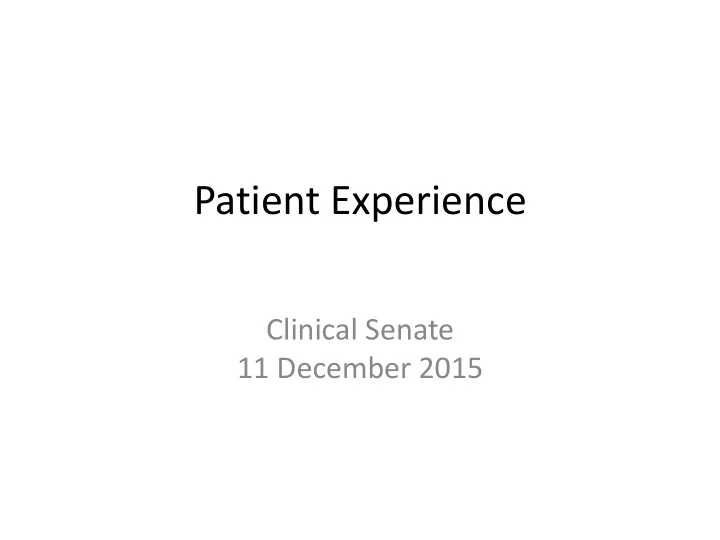

Patient Experience Clinical Senate 11 December 2015
WA Patient Satisfaction Survey The survey looks at the key areas of health care that are important. These may include: • hospital access (including assistance, special aids, parking and signage) • the support and reassurance received by patients • the politeness and consideration with which patients were treated • patients’ confidence in the healthcare professionals • the provision of pain relief • whether services met the patients’ expectations • health outcomes • patients’ involvement in decisions about their care and treatment • waiting room amenities • the quality and quantity of food. In 2014-15, 8000 people were surveyed of their experience in a general or maternity hospital or attendance at an emergency department or outpatient clinic. 97 % survey participation rate (1490 emergency patients, 4387 admitted patients, 1222 maternity patients, 934 outpatients interviewed).
WA Patient Satisfaction Survey Satisfaction with aspects of healthcare
WA Patient Satisfaction Survey
Consumer feedback Via internet (data from WACHS YTD, this represents 1% of total complaints received) Press Ganey Via feedback forms and drop boxes inpatient survey Customer Liaison Officers (measures patient Ministerials, HADSCo, AHPRA satisfaction and experience) DATIX CIMS/Consumer Feedback Module Management of specific incident Reporting to Hospital Executives Communication with team, S&Q staffs, Consumer/Community co-director, patient Advisory Committee, MAC Reporting to DOH, HADSCo
Performance against Standard 2 Jan 2014-Dec 2014 Met with merit Not met Consumers/carers involved in health Consumers/carers actively involved in service governance safety and quality decision making Health service has mechanisms for Health service provides orientation and engaging consumers/carers in ongoing training for consumers/carers for strategic/operational planning them to fulfil their partnership role Consumers/carers feedback on patient Consumers/carers involved in training information publications clinical workforce Action taken to incorporate feedback Consumers/carers participate in from consumer/carer into publications evaluation of patient feedback data Consumer/carers participate in design and redesign of health services Public sites achieving met with merit included Women and Newborn Health Service (2.1.1), Armadale Kelmscott HS (2.1.1, 2.2.1, 2.4.1, 2.5.1), Swan Kalamunda HS (2.4.1, 2.6.2), Rockingham Peel Group (2.1.1) Source: Licensing Accreditation Regulatory Unit
Summary • Core elements of standard 2 met but work to address developmental goals needed. • Patients mostly satisfied with care but we could improve in informing and involving patients in their treatment. • Less defensive approach to patient feedback. • Tools to measure patient outcomes.
Other resources: Procedure specific information sheets Patient Stories – personal stories and where to get help information
Source: Royal Children’s Hospital Melbourne
Continuum of care • NaCS (Notifications and Clinical Summaries) – capacity to be uploaded to patient’s e -health record • Continuity of medication management – between hospital and community settings • Telehealth • Community focused complex care coordination teams
Our challenge • Providing seamlessness in services within a devolved governance model • Whose responsibility is it to identify and address gaps? • How do we ensure responsiveness to addressing barriers to continuity of care?
Workshop 9 December 2015 • Overwhelming consensus on continued need and work to refresh • Opportunity to engage across health siloes • Opportunity to create consistency and standardisation across the system • Need a shared vision and guiding principles from which action plans can be developed. • 4 th C for the clinician?
• Increasing focus on medical engagement and leadership • Focus on aptitude and attitude vs competency • Focus on performance management
Recommend
More recommend